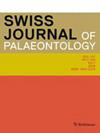圣乔治山(瑞士,意大利)的海洋保护矿床:三叠纪黑色页岩 Lagerstätten 的原型
IF 2.2
2区 地球科学
Q1 PALEONTOLOGY
引用次数: 0
摘要
海洋保护沉积("Konservat-Lagerstätten")的特点在于其化石保存方式、动物组成和沉积面貌。在此,我们回顾了著名的贝萨诺地层保护沉积(前格伦兹比图门岗,包括安尼西-拉迪尼边界)以及较年轻的含化石单元卡瓦下层、卡瓦上层、卡西纳床和圣乔治山(瑞士和意大利)的卡尔斯奇铁矿带的这些特征。我们将这些单元与全球新生代和埃迪卡拉纪的部分重要黑色页岩型Lagerstätten进行了比较,以便利用主成分和分层聚类分析发现它们在面貌、成因和化石含量方面的共性。此外,我们还根据化石含量,将圣乔治山类型化石矿床与全球其他可比的三叠纪矿床进行了比较。根据主成分分析和聚类分析的结果,我们将所分析的 45 个 Lagerstätten 分为四组,并建议使用相应的先驱地点:早古生代黑色页岩属于伯吉斯类型,三叠纪黑色页岩属于圣乔治山类型,富含黄铁矿的黑色页岩属于霍尔茨马登类型,板状灰岩属于索尔恩霍芬类型。本文章由计算机程序翻译,如有差异,请以英文原文为准。
The marine conservation deposits of Monte San Giorgio (Switzerland, Italy): the prototype of Triassic black shale Lagerstätten
Marine conservation deposits (‘Konservat-Lagerstätten’) are characterized by their mode of fossil preservation, faunal composition and sedimentary facies. Here, we review these characteristics with respect to the famous conservation deposit of the Besano Formation (formerly Grenzbitumenzone; including the Anisian–Ladinian boundary), and the successively younger fossil-bearing units Cava inferiore, Cava superiore, Cassina beds and the Kalkschieferzone of Monte San Giorgio (Switzerland and Italy). We compare these units to a selection of important black shale-type Lagerstätten of the global Phanerozoic plus the Ediacaran in order to detect commonalities in their facies, genesis, and fossil content using principal component and hierarchical cluster analyses. Further, we put the Monte San Giorgio type Fossillagerstätten into the context of other comparable Triassic deposits worldwide based on their fossil content. The results of the principal component and cluster analyses allow a subdivision of the 45 analysed Lagerstätten into four groups, for which we suggest the use of the corresponding pioneering localities: Burgess type for the early Palaeozoic black shales, Monte San Giorgio type for the Triassic black shales, Holzmaden type for the pyrite-rich black shales and Solnhofen type for platy limestones.
求助全文
通过发布文献求助,成功后即可免费获取论文全文。
去求助
来源期刊

Swiss Journal of Palaeontology
Earth and Planetary Sciences-Paleontology
CiteScore
4.30
自引率
16.70%
发文量
17
审稿时长
4 weeks
期刊介绍:
The Swiss Journal of Palaeontology publishes original research and review articles of interest to the international community in the fields of palaeontology, taxonomy and systematics, while recognising at the same time the importance of documenting high-quality palaeontological data in a regional context. Palaeobiology in combination with alpha taxonomy is a core topic of the journal.
Submitted papers should have an appeal as wide as possible, directed towards an international readership. Contributions should not have been simultaneously submitted elsewhere, and the overlap of content between related articles should be minimal. Duplications of text and the use of previously published illustrations without adequate citation are unacceptable. If a manuscript has two or more authors, both or all have to sign to confirm they all were involved in the work and have agreed to its submission. The preferred manuscript language is UK English, but consistently used US English is also acceptable. We encourage the publication of proceedings of international meetings as well as special thematic issues. Short contributions and book reviews are also accepted.
An international editorial team as well as guest editors guarantee that the thematic issues as well as all articles in regular issues are peer-reviewed and meet the highest standards.
 求助内容:
求助内容: 应助结果提醒方式:
应助结果提醒方式:


